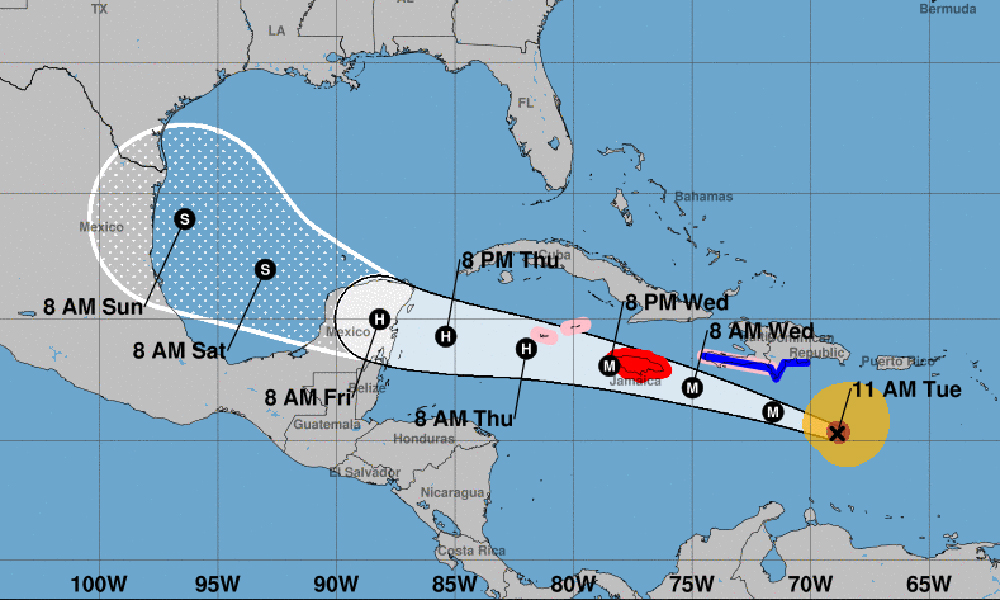Hurricane Beryl continued to rapidly intensify on Tuesday morning, reaching a powerful Category 5 hurricane with maximum sustained winds of 160 mph, the National Hurricane Center said.
“Life-threatening” winds and potentially 5 to 8 feet of storm surge are forecast to strike Jamaica on Wednesday, despite some potential weakening during the day Tuesday. It will likely remain a major hurricane as it takes a track over or just south of Jamaica.
Beryl is forecast to bring 4 to 8 inches to Jamaica on Wednesday, with up to 1 foot in some areas.
Haiti and the Dominican Republic are not in the direct path of Beryl, but is close enough to bring a potential storm surge of 2 to 4 feet along the southern coasts, the hurricane center said. Tropical storm conditions are forecast to arrive in Haiti and the Dominican Republic on Tuesday, while the Cayman Islands will experience hurricane conditions.
Southern areas of Haiti and the Dominican Republic will be affected by Beryl’s outer bands Tuesday into Wednesday, with 2 to 6 inches of rain possible.
Over the weekend, Beryl became the strongest June hurricane on record, with maximum sustained winds of 140 mph. It was the first Category 4 storm to occur in June and the earliest Category 4 on record in the Atlantic Basin. On Sunday, Beryl rapidly intensified from a tropical storm to a major hurricane in just 42 hours.
Beryl made landfall Monday in the Grenadine Islands north of Grenada as a powerful Category 4 storm with sustained winds of 155 mph, just shy of the minimum Category 5 threshold of 157 mph.
As of 11 a.m. Tuesday, Beryl was about 235 miles southeast of Isla Beata in the Dominican Republic and 555 miles east-southeast of Kingston, Jamaica. The hurricane is traveling west-northwest at 22 mph.
Hurricane-force winds extend outward up to 40 miles from the center and tropical-storm-force winds extend outward up to 175 miles.
All of Jamaica and parts of Mexico and Belize were within Beryl’s cone Tuesday.
Grand Cayman, Little Cayman and Cayman Brac were under a hurricane watch Tuesday.
A tropical storm warning is in effect for the Dominican Republic from Punta Palenque west to the border with Haiti. A hurricane watch is now in effect for the south coast of Haiti from the border with the Dominican Republic to Anse d’Hainault.
Beryl is not expected to affect South Florida.
It should reach Mexico’s Yucatan Peninsula by Friday. Once the storm crosses the Yucatan and is over water once again, it will be weaker, but its potential path broadens, and could include Southern Texas.
Related Articles
Lush flowers are sending a warning about California’s wildfire season
Intense Bay Area heat to crank up even more, and it may last longer than anticipated
Road repairs estimated at $3 million after Santa Cruz Mountains landslide
State Farm seeks ‘massive’ insurance rate hike for California homeowners
$20 billion for climate change and school construction bonds heading toward November ballot
Forecasters also said that a tropical wave, located about 1,000 miles east of the Windward Islands in the Atlantic on Monday, could become a tropical depression by midweek as it moves toward the eastern and central Caribbean.
It has a 20% chance of developing in the next two days, while forecasters have reduced its chance of developing in the next seven days to 30%.
It is expected to move west at 15 mph to 20 mph, forecasters said.
The next storm to form would be Debby.
The western Gulf of Mexico generated the 2024 season’s first tropical storm last week. Dubbed Alberto, the system made landfall in Mexico 250 miles south of the U.S. border, but sent storm surge and flood to spots 500 miles away in Louisiana.
A second system is moving across the Atlantic Basin. Forecasters have reduced its chanced of developing to 30%. (Courtesy NHC)
The 2024 hurricane season, which officially began June 1, is expected to be extremely active.
In its annual May outlook, the National Oceanic and Atmospheric Administration said that the 2024 hurricane season has an 85% chance of being above normal, with 17 to 25 named storms with minimum sustained winds of 39 mph, and eight to 13 hurricanes. An average year has 14 named storms and seven hurricanes.
In addition, NOAA has forecast four to seven major hurricanes for 2024, meaning those that are Category 3 or above.
Experts at Colorado State University stated in their 2024 forecast that the U.S. East Coast, including Florida, had a 34% chance of a major hurricane making landfall this year. The average from 1880-2020 was 21%.
Forecasters say that the record-warm water temperatures that now cover much of the Atlantic Ocean will continue into peak hurricane season from August to October. That warm water fuels hurricanes. By early June, the tropical Atlantic was already as hot as it usually is in mid-August — peak hurricane season.
Hurricane season officially ends Nov. 30.












